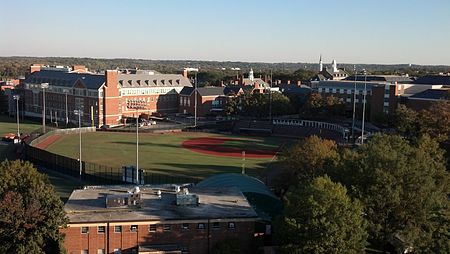Bob Turtle Smith Stadium

Shipley Field at Bob "Turtle" Smith Stadium is a baseball stadium in College Park, Maryland. It has served as the home field of the Maryland Terrapins baseball team at the University of Maryland since 1954. Shipley Field was formerly the home of the College Park Bombers of the Cal Ripken, Sr. Collegiate Baseball League, and was also used as a baseball venue by the Bowie Baysox during the 1994 season. The major league Washington Senators held a practice at Shipley Field on April 8, 1968, when their Opening Day game was postponed in the aftermath of the assassination of Martin Luther King Jr.The stadium holds 2,500 people and opened on April 3, 1954. It was dedicated as Shipley Field to former Maryland baseball coach Burton Shipley on March 28, 1956. On May 8, 2010, it was re-dedicated as Bob "Turtle" Smith Stadium.In 2004, a new artificial turf replaced an older turf installation in the stadium's infield, and improvements were made to the under field drainage system. After the 2015 season, the artificial turf infield and bermuda grass outfield were replaced with a FieldTurf surface; new drainage was installed underneath; a home team closed off bullpen was created in left field foul territory; both bullpens received FieldTurf surfaces; and the outfield wall was moved father out.
Excerpt from the Wikipedia article Bob Turtle Smith Stadium (License: CC BY-SA 3.0, Authors, Images).Bob Turtle Smith Stadium
Fieldhouse Drive, College Park Old Town
Geographical coordinates (GPS) Address Nearby Places Show on map
Geographical coordinates (GPS)
| Latitude | Longitude |
|---|---|
| N 38.989166666667 ° | E -76.944166666667 ° |
Address
Fieldhouse Drive
20742 College Park, Old Town
Maryland, United States
Open on Google Maps







